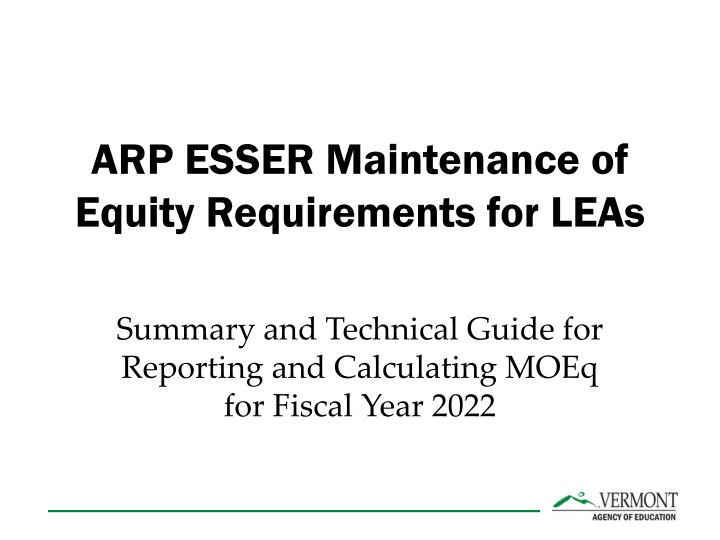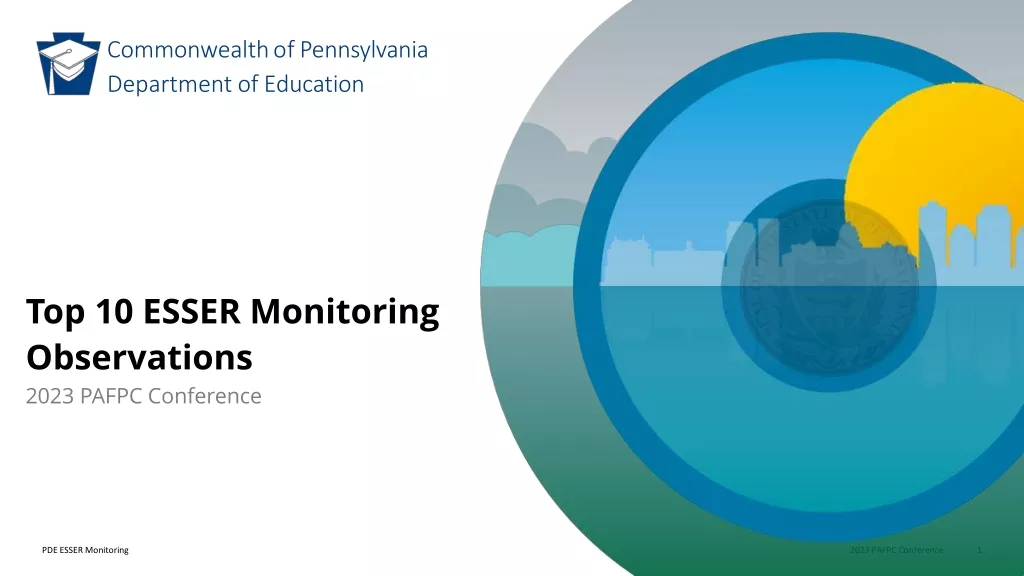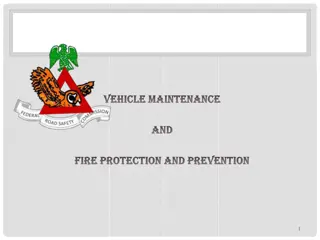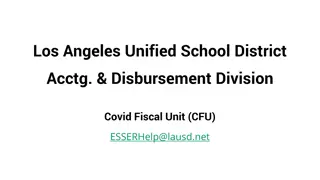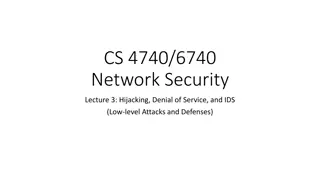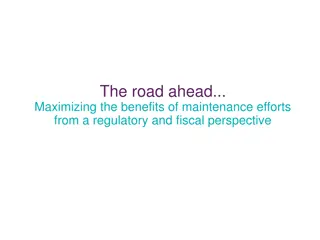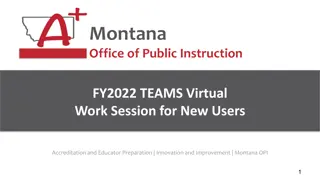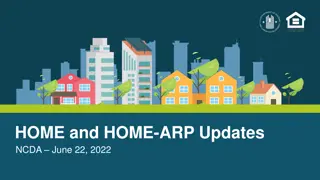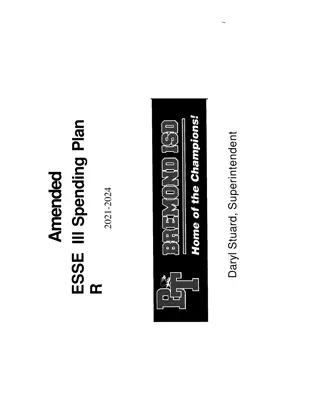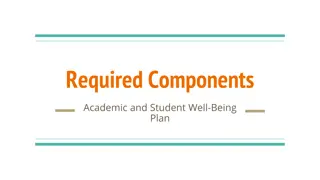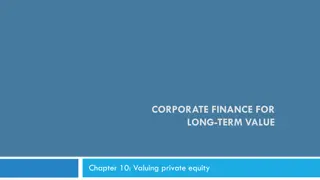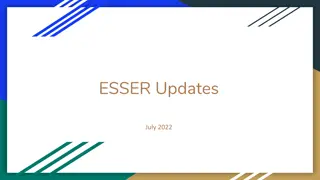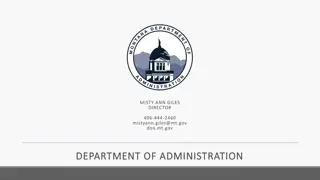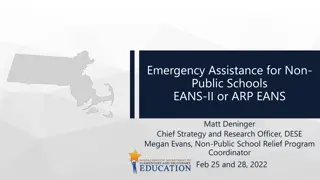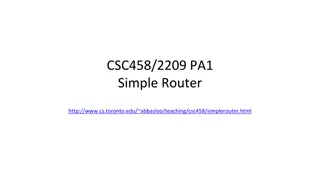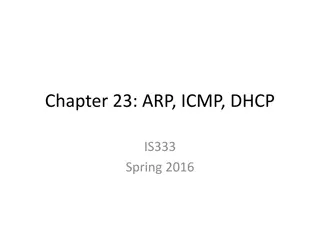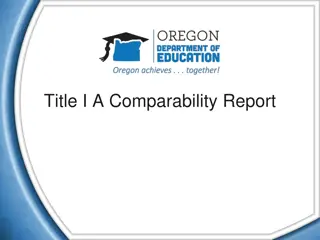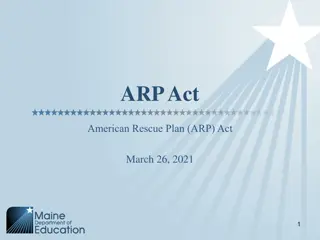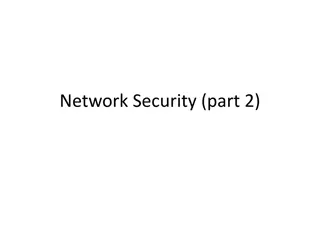ARP ESSER Maintenance of Equity Requirements for LEAs FY 2022
Maintenance of Equity (MOEq) in ARP ESSER ensures that Local Education Agencies (LEAs) do not disproportionately reduce funding or staff in high-poverty schools. LEAs must meet specific requirements to receive funds and report on equity maintenance. Updates and reporting deadlines are outlined for FY 2022 and FY 2023.
Download Presentation

Please find below an Image/Link to download the presentation.
The content on the website is provided AS IS for your information and personal use only. It may not be sold, licensed, or shared on other websites without obtaining consent from the author.If you encounter any issues during the download, it is possible that the publisher has removed the file from their server.
You are allowed to download the files provided on this website for personal or commercial use, subject to the condition that they are used lawfully. All files are the property of their respective owners.
The content on the website is provided AS IS for your information and personal use only. It may not be sold, licensed, or shared on other websites without obtaining consent from the author.
E N D
Presentation Transcript
ARP ESSER Maintenance of Equity Requirements for LEAs Summary and Technical Guide for Reporting and Calculating MOEq for Fiscal Year 2022
US Department of Education Guidance Federal Register :: Final Requirements- American Rescue Plan Act Elementary and Secondary School Emergency Relief Fund (June 9, 2022) MOEq FAQs USED MOEq website USED MOEq webinar and slide deck (June 9, 2022)
What is Maintenance of Equity ( What is Maintenance of Equity (MOEq MOEq)? )? MOEq is a set of new fiscal equity requirements in ARP ESSER. Specifically, MOEq ensures the following: An LEA does not disproportionately reduce State and local per-pupil funding in high- poverty schools. An LEA does not disproportionately reduce the number of full-time-equivalent (FTE) staff per-pupil in high-poverty schools.
What MOEq requirements apply to an LEA? Under section 2004(c) of the ARP Act, as a condition of receiving ARP ESSER funds, an LEA may not, in each of FY 2022 or 2023 Reduce combined State and local per-pupil funding for any high-poverty school (see Question 23) by an amount that exceeds the total reduction, if any, of combined State and local per-pupil funding for all schools in the LEA. Reduce the number of FTE staff per-pupil in any high-poverty school by an amount that exceeds the total reduction, if any, of FTE staff per-pupil in all schools in the LEA.
Updates from USED June 8, 2022
Reporting Requirements July 8, 2022 (AOE has received an extension of this deadline to August 31, 2022) - SEAs publish LEA exceptions, identify high-poverty schools for FY 2022, and describe how the SEA will ensure that each LEA that is not excepted from the LEA-level maintenance of equity requirements is maintaining equity in its high- poverty schools. November 1, 2022 SEAs publish LEA exceptions and identify high-poverty schools for FY 2023 December 31, 2022 SEAs publish applicable LEA high- poverty school data for FY 2022 December 31, 2023 SEAs publish applicable LEA high- poverty school data for FY 2023
August 31, 2022, Requirements By August 31, 2022, the SEAs must publish: The identity of each LEA excepted from MOEquity requirements for each of the following reasons: Total enrollment of less than 1,000 students. Operates a single school. Serves all students within each grade span with a single school. Has notified the SEA that is has not implemented an aggregate reduction in combined state and local per-pupil funding. Was granted an exception from ED and ED informed the SEA of the exception. For each LEA that is not excepted and does not maintain equity in FY 22, a list of the high-poverty schools in the LEA
August 31, 2022 Requirements (cont) A description of how the SEA will ensure that each LEA that is not excepted from LEA-level maintenance of equity requirements is maintaining equity in its high- poverty schools. This description should include information on: when the SEA will determine LEAs are not compliant and the date that the SEA will require non-compliant LEAs to describe what adjustments the LEA will make to be in compliance prior to the start of the next school year
How will AOE collect local MOEqdata? The AOE has developed a data collection in GMS. ARP ESSER Maintenance of Equity is located under FY 23 Central Data Collections Can be completed by anyone with ARP ESSER permissions, but must be submitted by Superintendent Due August 5, 2022
Are any LEAs exempt from the Are any LEAs exempt from the MOEquity requirements? requirements? MOEquity Yes. Under section 2004(c)(2) of the ARP Act, an LEA need not maintain equity if the LEA 1. Has a total enrollment of less than 1,000 students; 2. Operates a single school; 3. Serves all students within each grade span with a single school; or 4. Demonstrates an exceptional or uncontrollable circumstance, such as unpredictable changes in student enrollment or a precipitous decline in the financial resources of the LEA as determined by the Secretary (more information on slides 47 and 48) **LEAs must still complete the GMS Data Collection, even if they meet one of the above criteria.**
What data does an LEA need to complete the MOEqData Collection for FY 22? Student enrollment data for FY21 and FY22 for the entire LEA and for each school Consolidated Federal Programs (CFP) School Ranking data for FY 21 and FY 22 (AOE recommended data set) FTE data for FY21 and FY22 for every school in the LEA (see Slides 41-43 for Definitions on Staffing Equity) FY21 and FY22 final, voter-approved budgets for the LEA and for each school in the LEA (recommended by AOE)
What does fiscal year mean when determining MOEq? For purposes of determining MOEq, VT LEAs should use the state fiscal year when determining MOEq State Fiscal Year (Example) School Year FY 2022 July 1, 2021-June 30, 2022 2021- 2022 FY 2023 July 1, 2022-June 30, 2023 2022-2023
At what point in a fiscal year does an SEA or At what point in a fiscal year does an SEA or LEA determine whether it maintained equity? LEA determine whether it maintained equity? Each SEA and LEA must officially determine whether it maintained equity once it has final appropriated and allocated amounts that are available for current expenditures for each LEA or school, respectively, for the applicable fiscal year. (See FAQ Questions 17 and 26.)
Demonstrating LEA-Level MOEq For the purpose of demonstrating compliance with the MOEq requirements, the AOE recommends that an LEA use: allocations or budget data in this case, the AOE recommends using voter-approved budgets * Please Note: an LEA may choose to use actual expenditure, rather than budget data to calculate MOEq. The US Department of ED acknowledges that LEAs using per-pupil expenditures will not know whether they maintained equity until after the school year ends and, thus, will not be able to remedy a maintenance of equity violation for that school year.
Identifying High-Poverty Schools: Technical Guidance
What is a high What is a high- -poverty school? poverty school? A high-poverty school is, with respect to a school served by an LEA, a school that is in the highest quartile of schools served by the LEA based on the percentage of economically disadvantaged students in the school. An LEA may determine its high-poverty schools on a district-wide basis or by grade span. See FAQ 25
What measures must be used to determine What measures must be used to determine whether a school is high whether a school is high- -poverty? poverty? AOE recommends that LEAs use their FY 21 and FY 22 Consolidated Federal Programs (CFP) Targeting and Ranking data when calculating their high-poverty schools Under ESEA Section 1113(a)(5), LEAs must select one of five measures of poverty to determine relative percentages of children from low-income families residing in their attendance areas. Those five measures are: 1. Census counts of children from families below the poverty level (this is the same data used by the federal government to allocate Title I funds to districts). 2. Counts of children eligible for free and reduced-price school meals. 3. Counts of children whose families receive assistance under the federal welfare program Temporary Assistance for Needy Families. 4. Counts of children eligible for Medicaid. 5. A combination of two or more of these data sources
How does an LEA identify its high How does an LEA identify its high- -poverty schools? poverty schools? An LEA determines its high-poverty schools using the following procedures. An LEA may elect, consistent with the statute and as shown in the following examples, to make the determination on a districtwide basis or by grade span. (See sections 2004(c)(1)(A) and (c)(2)(C) of the ARP Act.) In deciding which option to use to identify its high-poverty schools, an LEA might consider factors such as the total number of high- poverty students impacted, relative concentrations of poverty in schools that would be identified compared to those that would not, and whether using grade spans would capture high schools if they would not otherwise be captured. An LEA may choose grade span to account for varying per-pupil allocations or FTEs per-pupil by grade span (e.g., elementary schools vs high schools) that aggregate (district-wide) per-pupil allocations or FTEs across all schools might not reflect.
Identifying high Identifying high- -poverty schools: Step 1 poverty schools: Step 1 Rank each school in the LEA by its percentage of economically disadvantaged students, from highest percentage to lowest percentage, in each fiscal year. An LEA may rank its schools within the LEA as a whole or within each grade span e.g., K-5, 6-8, 9-12. See Slide 24 for an example of how an LEA might rank all schools in the LEA as a whole and Slide 26 for an example of how an LEA might rank its schools by grade span.
Identifying high Identifying high- -poverty schools: Step 2 poverty schools: Step 2 Divide the total number of schools in the LEA by 4 to determine the number of schools in the highest quartile. If the result of the division is not a whole number, always round up to the nearest whole number (e.g., in Slide 24 table, 9 schools divided by 4 equals 2.25 schools, so 2.25 is rounded up to 3 schools). This is the number of schools the LEA must identify as high-poverty schools.
Identifying high Identifying high- -poverty schools: Step 3 poverty schools: Step 3 Identify the highest-poverty quartile of schools (the number of schools identified in step 2) in the LEA as high-poverty schools. If the LEA ranks by grade span, an LEA may first select the high-poverty school in rank order from each grade span. LEAs may determine their grade span and may use the same grade spans as for Title I Comparability. (See Slide 26) If they select the grade span option, LEAs must ensure that their highest quartile for each grade span is captured. For example, if an LEA has 9 schools, then 3 schools must be identified as highest poverty.
Identifying high Identifying high- -poverty schools (District poverty schools (District- -wide): Identifying high Identifying high- -poverty schools in an LEA as a whole (in a sample LEA with nine poverty schools in an LEA as a whole (in a sample LEA with nine schools) schools) wide): School Percentage of Economically Disadvantaged Students 80% 75% 65% 60% 40% 35% 25% 25% 15% Grade Span High-Poverty School? School A School B School C School G School I School D School E School H School F Elementary Elementary Elementary Middle High Elementary Elementary Middle Elementary Yes Yes Yes No No No No No No
Identifying high Identifying high- -poverty schools (Grade Span): poverty schools (Grade Span): Identifying high Identifying high- -poverty schools by grade span in an LEA poverty schools by grade span in an LEA School Percentage of Economically Disadvantaged Students 80% 75% 65% 35% 25% 15% 60% 25% 40% Elementary Grade Span Middle Grade Span High School Grade Span X High- Poverty School School A School B School C School D School E School F School G School H School I X X X X X X Yes No No No No No Yes No Yes X X
High Poverty Schools (Grade Span Option)
Note on MOEqfor districts with only one school serving a grade span Example: your LEA has only one high- school That school is automatically your high- poverty school for that grade span That grade span automatically passes the MOEq fiscal and staffing equity test for that grade span (you will compare that school to itself) *you may still fail the MOEq test in other grade spans
Which funding sources must an LEA include when Which funding sources must an LEA include when determining its per determining its per- -pupil funding for the purposes of pupil funding for the purposes of maintaining fiscal equity? maintaining fiscal equity? When determining whether it maintained fiscal equity, an LEA includes all sources of State and local funds the LEA has available for current expenditures for free public education. (See section 8101(12) of the ESEA.) Current expenditures do not include dedicated funds for capital outlays and debt service. Moreover, local fiscal MOEq considers the use of local and State funding sources only. Therefore, an LEA may not include Federal funds or support from private donors, such as charitable contributions that corporations or individuals make to elementary and secondary education. The LEA must use consistent funding sources from year to year and document its sources of data.
What enrollment data may an LEA rely on when determining its per-pupil amount of funding for high poverty schools? To determine the per-pupil amount for each fiscal year, an LEA may use the most appropriate available enrollment data for the applicable fiscal year, which could be the same enrollment data it relied on to distribute or allocate funds for the applicable fiscal year. For the purposes of this report, the AOE recommends that the LEA use its DC-6 enrollment data. Please Note: LEAs should not include their preK enrollment.
How does an LEA determine whether it maintained fiscal How does an LEA determine whether it maintained fiscal equity for its high equity for its high- -poverty schools? District District- -wide Determination wide Determination poverty schools? Examples Per-pupil High-poverty School 1 Per- pupil Reduction High-poverty School 2 Per- pupil Reduction High-poverty School 3 Per- pupil Reduction 1. Determine the per-pupil reduction of State and local funding, if any, for FY 2022 in the LEA as a whole: State and local per-pupil amount for FY 2022 State and local per-pupil amount for FY 2021 State and local per-pupil reduction in State and local funds, if any, for FY 2022 2. Determine the per-pupil reduction of State and local funding, if any, for FY 2022 for each high-poverty school in the LEA. High-poverty school per-pupil amount for FY 2022 High-poverty school per-pupil amount for FY 2021 High-poverty school per-pupil reduction in State and local funds, if any, for FY 2022 3. Compare the per-pupil reduction, if any, for each high-poverty school (step 2c above) with the per-pupil reduction in State and local funds to all schools in the LEA (step 1c above). If any high-poverty school receives a reduction in the per-pupil amount of State and local funds that is greater than the amount in step 1c, the LEA has not maintained fiscal equity under section 2004(c)(1)(A) of the ARP Act for FY 2022 with respect to that high-poverty school. Reduction in State and Local Funds across All Schools in the LEA $0 Example 1 FY21 Per-Pupil Amount: $23,000 FY22 Per-Pupil Amount: $23,000 Per-Pupil Reduction: $0 FY21 Per-Pupil Amount: $24,050 FY22 Per-Pupil Amount: $24,000 Per-Pupil Reduction: $50 FY21 Per-Pupil Amount: $25,050 FY22 Per-Pupil Amount: $25,000 Per-Pupil Reduction: $50 Example 2 $50 FY21 Per-Pupil Amount: $25,150 FY22 Per-Pupil Amount: $25,000 Per-Pupil Reduction: $150 FY21 Per-Pupil Amount: $26,150 FY22 Per-Pupil Amount: $26,050 Per-Pupil Reduction: $100 FY21 Per-Pupil Amount: $27,150 FY22 Per-Pupil Amount: $27,100 Per-Pupil Reduction: $50 Example 3 $100 FY21 Per-Pupil Amount: $20,000 FY22 Per-Pupil Amount: $19,900 Per-Pupil Reduction: $100 FY21 Per-Pupil Amount: $19,000 FY22 Per-Pupil Amount: $18,900 Per-Pupil Reduction: $100 FY21 Per-Pupil Amount: $22,000 FY22 Per-Pupil Amount: $21,925 Per-Pupil Reduction: $75
District-wide Fiscal/Staffing Equity (District-wide): Step 1
District-wide Fiscal/Staffing Equity (District-wide): Step 2
District-wide Fiscal/Staffing Equity (District-wide): Step 3
How does an LEA determine whether it maintained fiscal How does an LEA determine whether it maintained fiscal equity for its high equity for its high- -poverty schools? Grade Span Determination Grade Span Determination poverty schools? 1. Determine the per-pupil reduction of State and local funding, if any, for FY 2022 in each grade span of the LEA: State and local per-pupil amount for FY 2022 State and local per-pupil amount for FY 2021 State and local per-pupil reduction in State and local funds, if any, for FY 2022 2. Determine the per-pupil reduction of State and local funding, if any, for FY 2022 for each high-poverty school in the respective grade span of the LEA. High-poverty school per-pupil amount for FY 2022 High-poverty school per-pupil amount for FY 2021 High-poverty school per-pupil reduction in State and local funds, if any, for FY 2022 3. Compare the per-pupil reduction, if any, for each high-poverty school (step 2c above) with the per-pupil reduction in State and local funds for all schools in that grade span (step 1c above). If any high-poverty school in any grade span receives a reduction in the per-pupil amount of State and local funds that is greater than the amount in step 1c for that grade span, the LEA has not maintained fiscal equity under section 2004(c)(1)(A) of the ARP Act for FY 2022 with respect to that high-poverty school.
District-wide Fiscal/Staffing Equity Grade Span: Steps 1 and 2
District-wide Fiscal/Staffing Equity (Grade Span: Step 3
How does an LEA determine which FTEs to include How does an LEA determine which FTEs to include when determining whether the LEA maintained when determining whether the LEA maintained staffing equity? staffing equity? Under section 2004(c)(1)(B) of the ARP Act, an LEA must maintain staffing equity in any high-poverty school. Each LEA must include all paid staff, both instructional and non-instructional when determining whether it maintained staffing equity on an FTE basis. This would include all employees and those hired by contract who perform school-level services. LEAs may refer to the ESSER APR Accounting Guide (pages 7-10) for FTE staffing data, but; LEAs will also need to include contracted staff using Obj/Funct codes 300 and 500 for school level services. The AOE recommends that LEAs pick a point in time and be consistent across years.
How does an LEA determine which FTEs to include when How does an LEA determine which FTEs to include when determining whether the LEA maintained staffing equity determining whether the LEA maintained staffing equity ( (cont cont)? )? An LEA includes staff who split their time between more than one school building in the LEA. For example, if a districtwide literacy coach supports teachers in two different schools, the LEA must include the proportional FTE for each school. In addition to the required MOEq determination for staffing in GMS, USED states that, An LEA is also encouraged to consider equity in terms of its overall staffing budget, which may include considering the qualifications and level of experience of staff in its high-poverty schools compared to other schools (FAQ 28)
Must an LEA account for changes in staffing or Must an LEA account for changes in staffing or enrollment during the school year? enrollment during the school year? An LEA determines whether it maintains staffing equity once both enrollment data and staffing decisions are final for a specific school year. Once an LEA has determined whether it has maintained staffing equity for each of its high-poverty schools, if there are unpredictable changes in student enrollment or personnel assignments later in the school year, the LEA does not have to redetermine staffing equity. LEAs should make every effort to ensure staffing equity is maintained throughout the school year.
How does an LEA determine whether it maintained staffing How does an LEA determine whether it maintained staffing equity for its high equity for its high- -poverty schools? District District- -wide determination wide determination poverty schools? 1. Determine the per-pupil reduction in FTEs, if any, for FY 2022 in the LEA as a whole: Districtwide FTE per-pupil for FY 2022 Districtwide FTE per-pupil for FY 2021 Districtwide per-pupil FTE reduction, if any, for FY 2022 2. Determine the per-pupil reduction of FTEs for each high-poverty school for FY 2022. High-poverty school FTE per-pupil for FY 2022 High-poverty school FTE per-pupil for FY 2021 High-poverty school FTE per-pupil reduction, if any, for FY 2022 3. Compare the per-pupil FTE reduction, if any, for each high-poverty school (step 2c above) with the per-pupil FTE reduction across all schools in the LEA (step 1c above). If any high- poverty school has a per-pupil FTE reduction (step 2c) that is greater than the per-pupil FTE reduction across the LEA (step 1c), then the LEA has not maintained staffing equity under section 2004(c)(1)(B) of the ARP Act for FY 2022. Example s Per-pupil FTE Reduction across All Schools in the LEA 0 High-poverty School 1 Per- pupil FTE Reduction High-poverty School 2 Per- pupil FTE Reduction High-poverty School 3 Per- pupil FTE Reduction Example 1 FY21 FTEs Per- Pupil: .50 FY22 FTEs Per- Pupil: .50 Per-Pupil Reduction: 0 FY21 FTEs Per- Pupil: .075 FY22 FTEs Per- Pupil: .050 Per-Pupil Reduction: .025 FY21 FTEs Per- Pupil: .050 FY22 FTEs Per- Pupil: .040 Per-Pupil Reduction: .01 Example 2 .05 FY21 FTEs Per- Pupil: .075 FY22 FTEs Per- Pupil: .015 Per-Pupil Reduction: .06 FY21 FTEs Per- Pupil: .15 FY22 FTEs Per- Pupil: .05 Per-Pupil Reduction: .10 FY21 FTEs Per- Pupil: .05 FY22 FTEs Per- Pupil: .045 Per-Pupil Reduction: .005 Example 3 .05 FY21 FTEs Per- Pupil: .30 FY22 FTEs Per- Pupil: .25 Per-Pupil Reduction: .05 FY21 FTEs Per- Pupil: .40 FY22 FTEs Per- Pupil: .36 Per-Pupil Reduction: .04 FY21 FTEs Per- Pupil: .20 FY22 FTEs Per- Pupil: .16 Per-Pupil Reduction: .04
How does an LEA determine whether it maintained staffing How does an LEA determine whether it maintained staffing equity for its high equity for its high- -poverty schools? Grade Span determination Grade Span determination poverty schools? 1. Determine the per-pupil reduction in FTEs, if any, for FY 2022 in each grade span served by the LEA: Districtwide FTE per-pupil for FY 2022 Districtwide FTE per-pupil for FY 2021 Districtwide per-pupil FTE reduction, if any, for FY 2022 2. Determine the per-pupil FTE reduction, if any, for FY 2022 for each high- poverty school in the LEA. High-poverty school FTE per-pupil for FY 2022 High-poverty school FTE per-pupil for FY 2021 High-poverty school FTE per-pupil reduction, if any, for FY 2022 3. Compare the per-pupil FTE reduction, if any, for each high-poverty school (step 2c above) for that grade span with the per-pupil FTE reduction across that grade span (step 1c above). If any high-poverty school in any grade span has a per-pupil FTE reduction (step 2c) that is greater than the per-pupil FTE reduction for that grade span (step 1c), the LEA has not maintained staffing equity for that grade span under section 2004(c)(1)(A) of the ARP Act for FY 2022.
What happens if an LEA does not meet MOEq? An LEA must meet both fiscal and staffing MOEq in FY 22 and FY 23. If an LEA does not meet MOEq, they may meet the criteria for an exceptional circumstance waiver. If they do not meet these criteria, USED has stated that If an LEA does not maintain equity and cannot make adjustments in that year, the LEA may make adjustments to funding and FTE staffing in the next year to ensure that high-poverty schools in the LEA are treated equitably.
Exceptional Circumstances 1. An LEA may demonstrate that it is excepted from the MOEquity requirements for FY 2022 by certifying that it did not and will not implement an aggregate reduction in combined State and local per-pupil funding in FY 2022 (i.e., is not facing overall budget reductions) (see Appendix B in FAQs) submit to AOE for certification. Submit request for exceptional or uncontrollable circumstance to USED. Some examples include (FAQ 32): 1. A very small school where the MOEquity calculations do not result in meaningful information about resource availability 2. Increased one-time expenditures in the baseline year (FY 21) due to the pandemic 3. Significant change in the expenses of a school that no longer serves a student whose educational and support needs required services that have a particularly high cost 2.
How can SEAs and LEAs ensure transparency How can SEAs and LEAs ensure transparency about about MOEquity MOEquity? ? Each LEA should consider making publicly available data and information such as: 1. Which schools are identified as high-poverty schools in the LEA and demographic information for each such school compared to the entire LEA; 2. The per-pupil amount of funding for each high-poverty school in the LEA in FYs 2021, 2022 and 2023; 3. The per-pupil amount of funding in the aggregate for all schools in the LEA in FYs 2021, 2022 and 2023; 4. The per-pupil number of FTEs for each high-poverty school in the LEA in FYs 2021, 2022 and 2023; 5. The per-pupil number of FTEs in the aggregate for all schools in the LEA in FYs 2021, 2022 and 2023; and 6. Whether the LEA did not maintain equity for any high-poverty school in FY 2022 or 2023.
Next Steps/Resources AOE will hold weekly office hours on Thursdays 10-11 through August 4. LEAs are encourage to bring questions and work in real time as they complete this data collection. Please direct all MOEq questions to Jill Briggs Campbell to ensure timely and coordinated responses. Thank you for your partnership!
